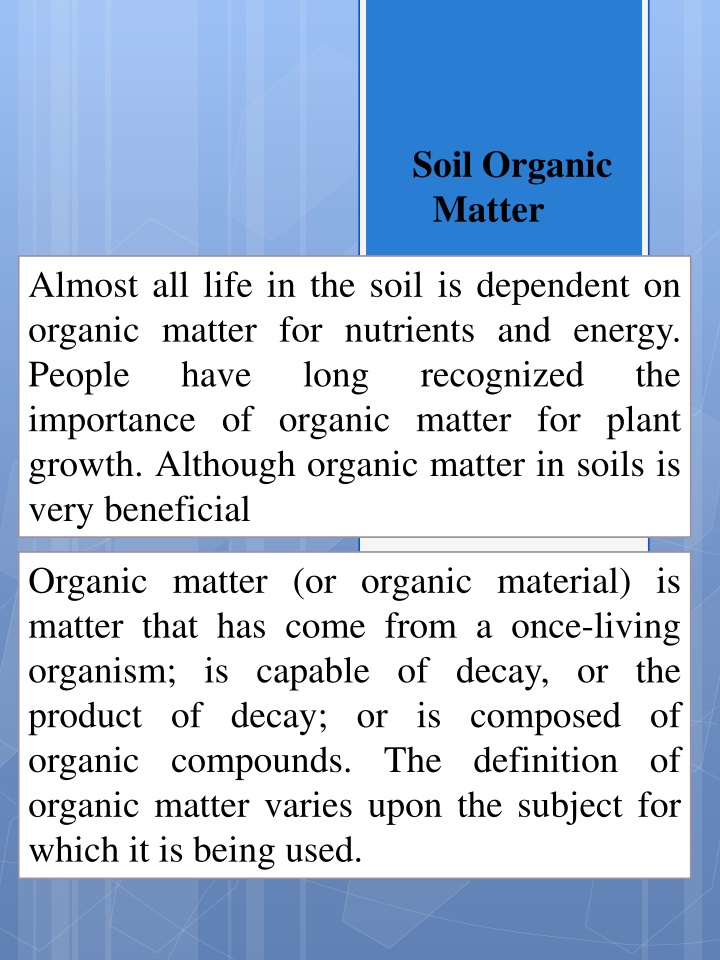
Soil Organic Matter and Its Importance in Ecosystems
Soil organic matter plays a crucial role in sustaining life in the soil, providing nutrients and energy to various organisms. This article explores the significance of organic matter for plant growth, decomposition processes, and ways to enhance organic matter content in soil. Discover the compositions, benefits, and factors influencing stable and labile organic matter in soils, shedding light on the vital role of organic material in sustaining ecosystems.
Download Presentation

Please find below an Image/Link to download the presentation.
The content on the website is provided AS IS for your information and personal use only. It may not be sold, licensed, or shared on other websites without obtaining consent from the author. If you encounter any issues during the download, it is possible that the publisher has removed the file from their server.
You are allowed to download the files provided on this website for personal or commercial use, subject to the condition that they are used lawfully. All files are the property of their respective owners.
The content on the website is provided AS IS for your information and personal use only. It may not be sold, licensed, or shared on other websites without obtaining consent from the author.
E N D
Presentation Transcript
Soil Organic Matter Almost all life in the soil is dependent on organic matter for nutrients and energy. People have long importance of organic matter for plant growth. Although organic matter in soils is very beneficial recognized the Organic matter (or organic material) is matter that has come from a once-living organism; is capable of decay, or the product of decay; or is composed of organic compounds. The definition of organic matter varies upon the subject for which it is being used.
The Organic Matter In Ecosystems The organic matter in an ecosystem consists of the organic matter above and below the soil surface. The distribution of organic matter in forest soil , expressed as organic carbon, was 38 percent in the trees and ground cover and 9 percent in the forest floor. The remaining 53 percent of the organic matter was in the soil and included the roots plus the organic matter associated with soil particles. Decomposition And Accumulation The primary or original source of soil organic matter (SOM) is the production of the primary producers-the higher plants. This organic material is subsequently decomposed by soil organisms. The result is the decomposition and the accumulation of organic matter in soils that has great diversity and a highly variable composition consumed and
There are several ways to quickly increase the amount of organic matter 1. Compost: Decomposed organic material. 2. Plant and animal material and waste: Dead plants or plant waste such as leaves or bush and tree trimmings, or animal manure. 3. Green manure: Plants or plant material that is grown for the sole purpose of being incorporated with soil. Labile Soil Organic Matter The labile fraction of SOM consists of any readily degradable materials from the plant and animal residues, and readily degradable microbial products. The labile organic matter composes about 10 to 20 percent of the total SOM. Labile organic matter is an important reservoir of nutrients because the nutrients, especially nitrogen, are rapidly recycled in the soil ecosystem.
Stable Soil Organic Matter The stable SOM fraction consists of resistant compounds: (1) in the decomposing residues, (2) in microbial products, and (3) that formed as a result of interaction of organic compounds with each other and with the mineral components of the soil, especially the clay. The stable organic matter is equivalent to humus. In soil science, humus refers to any organic matter that has reached a point of stability, where it will break down no further and might, if conditions do not change, remain essentially as it is for centuries. Polymers and plastics, although they may be organic compounds, considered organic material, due to their poor ability to decompose. A clam's shell, while biotic, would not be considered organic matter by this definition because of its inability to decay are usually not
The process of humification can occur naturally in soil, or in the production of compost. The importance of chemically stable humus is thought by some to be the fertility it provides to soils in both a physical and chemical sense. Physically, it helps the soil retain moisture by increasing microporosity, and encourages the formation of good soil structure. Chemically, the incorporation of oxygen into large organic molecular generates many active, negatively charged sites that bind to positively charged ions (cations) of plant nutrients, making them more available by ion exchange. assemblages Biologically, it allows soil organisms (microbes and animals) to feed and reproduce. Humus is often described as the life-force of the soil.
Figure : Sources and sinks of dissolved organic matter (DOM) in soils Sources: 1. Through fall 2. Root exudates; 3. Microbial lysis 4. Humification 5. Litter and root decomposition 6. Organic amendments Sinks: 7. Microbial degradation 8. Microbial assimilation 9. Lateral flow 10. Sorption 11. Leaching)
Generalized Representation of the Composting Process. Organic Matter Decomposition and the Formation of Humic Substances.
Benefits of soil organic matter and humus The mineralization process that converts raw organic matter to the relatively stable substance that is humus feeds the soil population of microorganisms and other creatures, thus maintaining high and healthy levels of soil life. The rate at which raw organic matter is converted into humus promotes (when fast) or limits (when slow) the coexistence of plants, animals and microbes in terrestrial ecosystems. Effective and stable humus are further sources of nutrients to microbes, the former providing a readily available supply while the latter acts as a more long-term storage reservoir.
Decomposition of dead plant material causes complex organic compounds to be slowly oxidized (lignin-like humus) or to break down into simpler forms (sugars and amino sugars, aliphatic and phenolic organic acids) which are further transformed into microbial biomass (microbial humus) or are reorganized (and still oxidized) in humic assemblages (fulvic and humic acids, humins) which bind to clay minerals and metal hydroxides. There has been a long debate about the ability of plants to uptake humic substances from their root systems and to metabolize them. There is now a consensus about humus as playing a hormonal role rather than a nutritional role in plant physiology. Humus is a colloidal substance, and increases the soil's cation exchange capacity, hence its ability to store nutrients by chelation as can clay particles; thus while these nutrient cations are accessible to plants, they are held in the soil safe from leaching away by rain or irrigation.
Humus can hold the equivalent of 8090% of its weight in moisture, and therefore increases the soil's capacity to withstand drought conditions. The biochemical structure of humus enables it to moderate or buffer excessive acid or alkaline soil conditions. During the humification process, microbes (bacteria and fungi) secrete sticky gums and mucilages; these contribute to the crumb structure of the soil by holding particles together, allowing greater aeration of the soil. Toxic substances such as heavy metals, as well as excess nutrients, can be chelated (that is, bound to the complex organic molecules of humus) and prevented from entering the wider ecosystem, thereby detoxifying it. The dark color of humus (usually black or dark brown) helps to warm up cold soils in the spring.






















